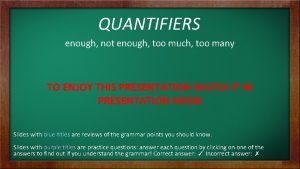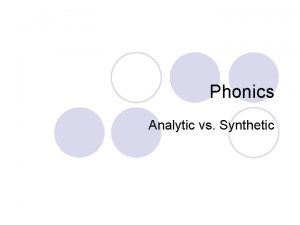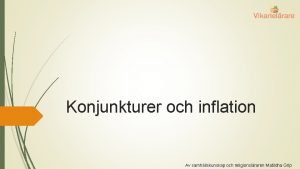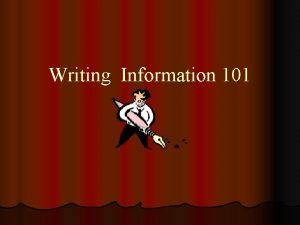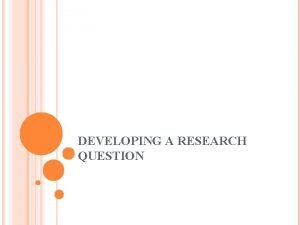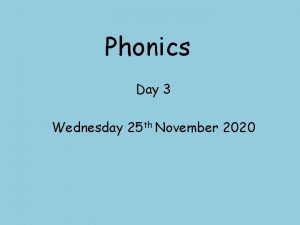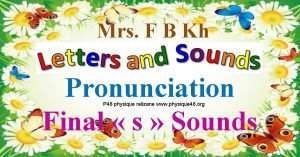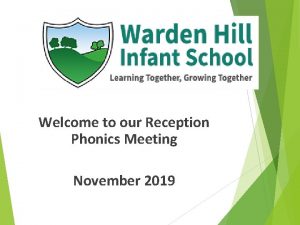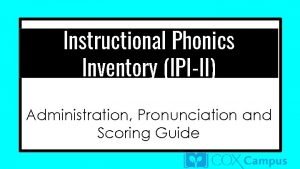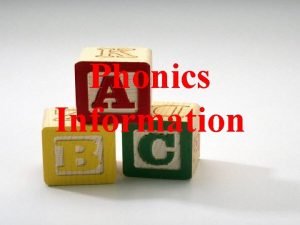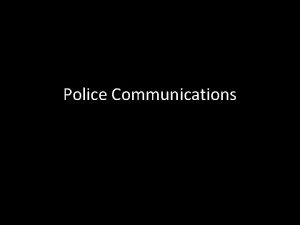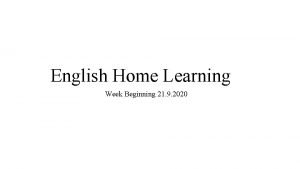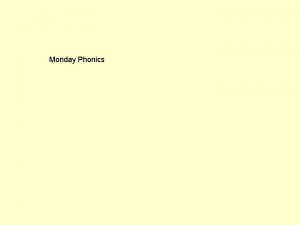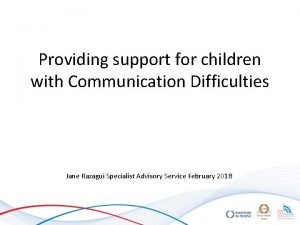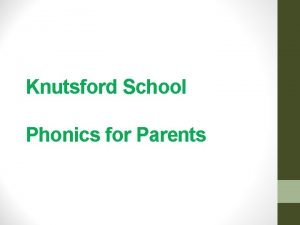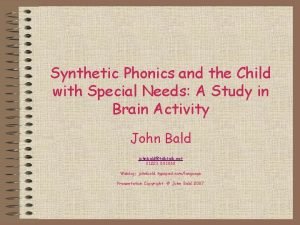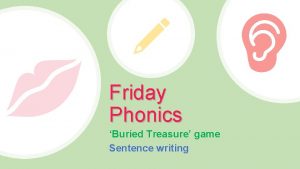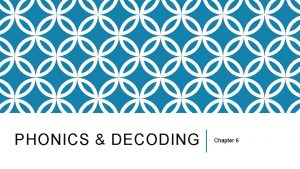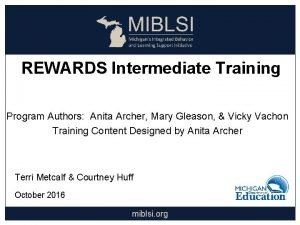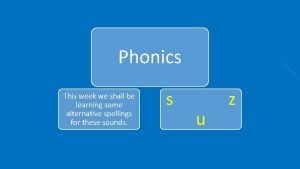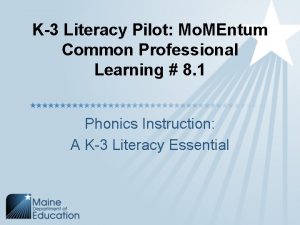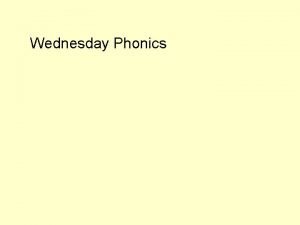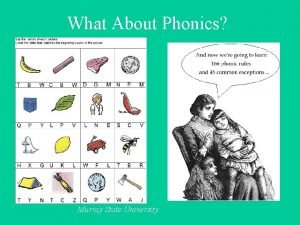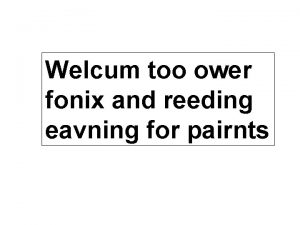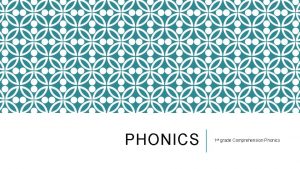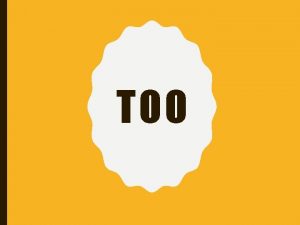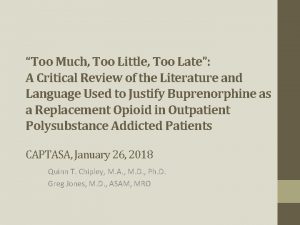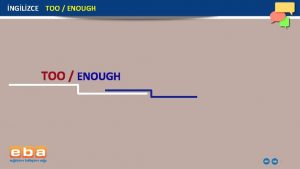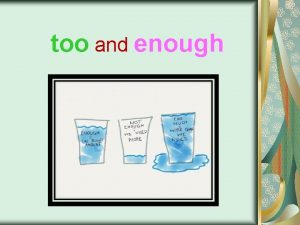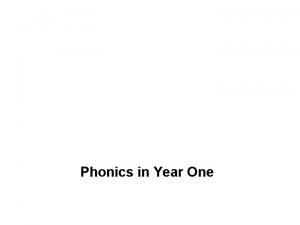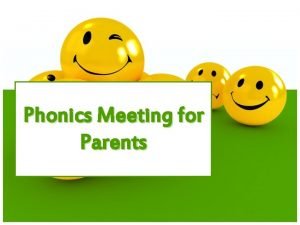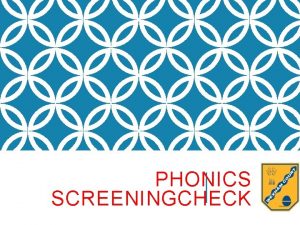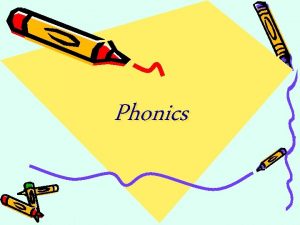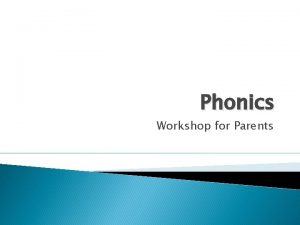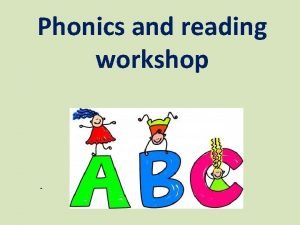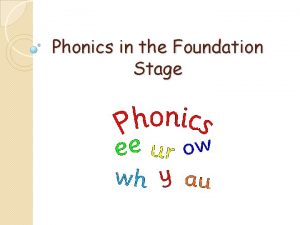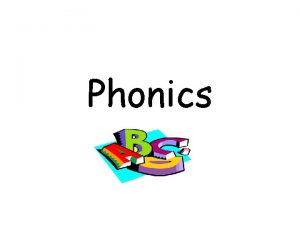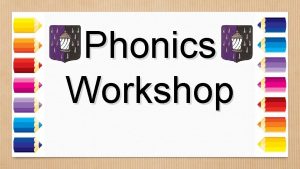Phonics Phonics or is that Fonix Welcum too







































- Slides: 39

Phonics, Phonics or is that Fonix? Welcum too ower fonix meating for pairnts. Wey hoap yew fined it yousful!

Our Aim Today… • For parents to find out about how we teach reading at John Hampden • For parents to gain an insight into how we teach phonics • For parents to gain some ideas about how they can support their children at home 2

So. . . How Do We Teach Reading At John Hampden School? 3

What is Phonics? Phonics is a way of teaching children to read quickly and skilfully. They are taught how to: • recognise the sounds that each individual letter makes • identify the sounds that different combinations of letters make - such as ‘sh’ • blend these sounds together from left to right to make a word • Children can then use this knowledge to ‘de-code’ new words that they hear or see. This is the first important step in learning to read. 4

Research • Research shows that when phonics is taught in a structured way - starting with the easiest sounds and progressing through to the most complex – it is the most effective way of teaching young children to read. It is particularly helpful for children aged 5– 7. • Almost all children who receive good teaching of phonics will learn the skills they need to tackle new words. They can then go on to read any kind of text fluently and confidently, and to read for enjoyment. • Children who have been taught phonics also tend to read more accurately than those taught using other methods, such as ‘look and say’. 5

Phonics is…. . 6

Phonics in Phases • Letters and Sounds provides a structured approach to the teaching of phonics. • Outline of phases 1 – 6 in Letters and Sounds 7

Phase 1 • Develops the speaking and listening skills which children need before they can begin to work with letters and sounds • Uses a range of games and activities within the daily routines • Uses ordinary objects and resources but focuses on listening • Uses oral work with letters NOT written work e. g. robot speak

Phase 2 • Introduces letters and the sounds they make • Children say the sound made by a given letter • Children identify the letter making a given sound • Introduces sound buttons • Introduces blending and segmenting • Develops blending and segmenting with vc words or cvc words • Introduces the first few High-frequency words, some decodable, some tricky words

Phase 3 • Teaches the last few single letters/sounds • Introduces letter names • Introduces digraphs – sounds made by 2 letters together sh ch oo These must be said as one sound not split • Introduces more High-frequency and tricky words down (decodable HF) was (non-decodable, Tricky) • Continues to blend and segment using the new letters/sounds

Phase 3 continued. . . • Continues using sound buttons • Uses captions and sentences to extend reading and writing The ship hit the rocks with a thud. • Introduces yes/no questions and sentence substitution to develop reading with understanding Is a lemon red? • Introduces 2 syllable words handbag toothbrush

Phase 4 • Introduces adjacent consonants in words tent jump • Continues blending & segmenting but moves away from sound buttons • Teaches more high-frequency and tricky words • Read and write sentences with words which have been introduced

The Phases and Expectations By the end of FS Children will be confident working in phases 1 -4. By the end of Year 1 Children will be confident working in phases 15. The majority of the children to be working securely in phase 5. By the end of Year 2 Children will be confident working in phases 1 -6. We would want the majority of children to be secure in phase 6.

What is the structure of an individual session? • Revisit & review – going over sounds/words already taught • Teach – learning new sounds/words • Practise – using these new sounds in words, reading/spelling • Apply – using known sounds/words in sentences, reading/writing

What is the structure of an individual session? • Revisit & review – going over sounds/words already taught • Articulation of sounds Articulation of Phonemes. mp 4

Blending The Letter Sounds • We play games to encourage children to listen to sounds in everyday life • We also play games to encourage children to listen to the process of blending, e. g. puppet talk and I spy 16

I Spy. . 17

Blending words sound buttons sat sock feet 18

Blending The Letter Sounds • Blending can be difficult for some children • Please do not worry if it takes your child a little longer – without pressure it will develop, but some children need extra help to hear sounds. • You could help by playing the games similar to those that we play in school, for example “Go and brush your t-ee-th” or “put on your c-oa-t. ” or look at a picture book and ask your child if he or she can find a d- o- g or the c- ow-s. • Spot the digraph first • In phase 4 children move onto blending four sounds – j-u-m-p 19

Silly Questions! 20

Can a cat run? 21

Can a crab clap? 22

Is this fun? 23

Can we stop now? 24

Tricky Words Phase 2 I to the no go into Phase 3 he she me be we you they all are me my her was Phase 4 said have like so do some come were there one little when out what 25

Key Words/ High Frequency Words Children will bring home a mixture of words that can be decoded and words that can not. Children need to build up to read them quickly. These words are words most commonly found in early reading books. The aim is for children to read them frequently so that they then become instantly recognisable, so that there is no need to decode or blend. 26

Key Words/ High Frequency Words Phase 2 Words it get as his not up on big got dad in if off can at is but had back an mum of him put a Tricky Words and I to the into no go 27

Reading Books • Books without words • Be positive 28

Reading Books – Walking through the text • Continue with discussion and looking at pictures feeding in the vocabulary, asking questions that will prompt what is in the text • Predict what might happen next • If a word is unknown encourage children to decode it. 29

Reading Books • Books will be changed on a Monday and Thursday, but we cannot change them unless there is a signature from home in the diary • Please ensure books are in school everyday • Little and often • Books are levelled in particular colour bands 30

Reading Books

Reading Books • My child finds this book too easy. • If a child cannot read 5 words the book is deemed as being too difficult. We want the children to read for meaning. 32

Reading Books • My child can easily answer questions. • Literal questions –the answer is in the text – What did Biff say to Mum? • Inferential questions – the answer needs to be thought about – Why was the key glowing? • Evaluative questions – there is no right or wrong answer – Did you enjoy the end of the story? Would you have changed it? 33

Reading Books • My child relies on the pictures. • Always encourage your child to look closely at the pictures as they ‘walk through the text. ’ Never cover them up. 34

Reading Books • My child has memorised the words. • This is the first stage of reading. Children need to develop memory skills. • My child has already had this book. • Sometimes a child chooses a book again because they enjoy it. 35

Reading Books : //www. oxfordowl. co. uk/for- 36

Key points for success • Children need good listening skills • Sounds must be pronounced correctly in order to blend them • Children need regular opportunities to blend and segment words, to practise and apply skills • Children should be praised for good attempts at blending • Children need to be praised for good phonic attempts at spelling • Children need to understand what they read

Working Together as a Partnership. “Every child deserves to discover that there is a whole world of bookish pleasures out there – all we have to do is open the gateway to let them through. ” 38

39
 Quantifiers too much too many enough
Quantifiers too much too many enough Fonix english
Fonix english Define analytic phonics
Define analytic phonics Just about right scale
Just about right scale Research question
Research question Too foreign for home
Too foreign for home Högkonjuktur inflation
Högkonjuktur inflation Too blessed to be stressed too anointed to be disappointed
Too blessed to be stressed too anointed to be disappointed Too broad and too narrow examples
Too broad and too narrow examples Too broad and too narrow examples
Too broad and too narrow examples Being too broad
Being too broad Sau thất bại ở hồ điển triệt
Sau thất bại ở hồ điển triệt Block nhĩ thất độ 2 mobitz 2
Block nhĩ thất độ 2 mobitz 2 Con hãy đưa tay khi thấy người vấp ngã
Con hãy đưa tay khi thấy người vấp ngã Thể thơ truyền thống
Thể thơ truyền thống Tôn thất thuyết là ai
Tôn thất thuyết là ai Walmart thất bại ở nhật
Walmart thất bại ở nhật Thơ thất ngôn tứ tuyệt đường luật
Thơ thất ngôn tứ tuyệt đường luật Gây tê cơ vuông thắt lưng
Gây tê cơ vuông thắt lưng Ngoại tâm thu thất chùm đôi
Ngoại tâm thu thất chùm đôi Tìm độ lớn thật của tam giác abc
Tìm độ lớn thật của tam giác abc Phonics play phase 5
Phonics play phase 5 How is kh pronounced
How is kh pronounced Phonics blom
Phonics blom Whezzle
Whezzle Phonics terminology
Phonics terminology Llll scope and sequence
Llll scope and sequence Police alphabet code
Police alphabet code Jolly phonics youtube
Jolly phonics youtube Mr thorne does phonics ay
Mr thorne does phonics ay Razagui
Razagui Phonics blom
Phonics blom Synthetic vs analytic phonics
Synthetic vs analytic phonics Buried treasure phonics
Buried treasure phonics Phonics chapter 6
Phonics chapter 6 Rewards anita archer
Rewards anita archer Phonics play obb and bob
Phonics play obb and bob Blending lines phonics
Blending lines phonics Ae sound words
Ae sound words Johnny phonics
Johnny phonics
